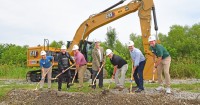
Economic Development for Community Leadership
Registration Now Open!
Choose Radius
Located in southern Indiana, the Radius Indiana region is surrounded by major infrastructure including interstates, private water ports, railways, and major airports. Our region’s proximity to major infrastructure as well as multitude of available state and verisite certified sites make the Radius region the perfect place to start, expand, or locate your business.
Choose Radius
Located in southern Indiana, the Radius Indiana region is surrounded by major infrastructure including interstates, private water ports, railways, and major airports. Our region’s proximity to major infrastructure as well as multitude of available state and verisite certified sites make the Radius region the perfect place to start, expand, or locate your business.
Whether you are a startup, an expanding business, or a multinational corporation, we invite you to discover why Southern Indiana is the right location for growing your business.
Radius Indiana can connect you to the resources to help launch your business. Whether you have a new idea, product or service, we can show you the path from creation to opening.
The Regional Impact Fund (RIF) is a sub-organization of Radius Indiana that supports economic area growth and expansion efforts of businesses throughout the Radius counties.

Who We Serve
Site Selectors and Investors
Radius Indiana provides site selectors and investors with the information and local expertise to make the best choice for locating or expanding a business in the region. Our team provides real-time data on the economic climate, workforce development initiatives, and state and local incentives to ensure that a company has access to all available resources needed to thrive in our region. The Radius Indiana Regional Impact Fund (RIF) is an additional resource that provides loans and grants to help businesses with gap funding that may be needed for infrastructure and site development and is the state's only regional deal-closing fund.

Who We Serve
Business Leaders
The Radius Indiana business leaders and owners are key to our economic development success throughout our region. We work with our business community to ensure they have the resources they need to grow and prosper. We have staff members dedicated to working with our established businesses who understand their challenges and needs so that we can create programs and initiatives to help find solutions and opportunities for growth. Our workforce development programs and talent attraction programs have been developed to meet the needs of our businesses and industries.

Who We Serve
Entrepreneurs
Our region is home to a vibrant entrepreneurial community. We connect entrepreneurs to business planning experts and funding resources to help a new business plant roots. Each year we host pitch competitions in a variety of categories from defense-related intellectual property to home-brewing with winners receiving cash awards to help cultivate their ideas. Our Spark Dowtown program also works to revitalize vacant buildings in our communities into re-imagined spaces ideal for new businesses and start-ups.

Who We Serve
Elected Officials
Radius Indiana works with our local officials to identify opportunities for growth in our region. Our team collaborates with local governments to help navigate land use and planning, infrastructure and funding challenges to position our counties and communities for expansion and investment. We host the "Radius Indiana Economic Development for Community Leadership" program regularly, which is a three-day course to educate our elected officials on the most important factors of economic development.

Who We Serve
Utility Partners
Our utility partners play an important role in our regional economic development efforts. Radius works closely with our utility to providers to ensure that sites for business development and expansion have the needed infrastructure and help plan for energy, usage, and capacity needs. Our utility partners are part of our community and often collaborate and co-sponsor our educational and marketing initiatives for the region.

Who We Serve
New Residents
Through our Choose Southern Indiana program we offer a $5,000 incentive to residents relocating to the Radius region. We also help connect new residents with employers looking for specific skill sets such as nursing or defense. The region has also become an ideal location for remote workers. In addition to our talent attraction initiatives, the program also offers activities and events for new residents to meet other new movers and learn more about their communities.

Program Highlight
Monon South Trail
The trail is slated to span nearly 60 miles through Lawrence, Orange, Washington, and Clark counties, with an additional portion completed through the city of New Albany. The final, full trail will traverse 62.3 miles through southern Indiana, making it the longest continuous trail in the state.

4/7/25
The Monon South Trail Team Released an Economic Impact Study at Their Second Annual Report to the Communities
SALEM, Ind. (April 2, 2025)— Radius Indiana hosted the second annual “Monon South Annual Report to the Communities...
3/27/25
Radius Indiana gives employers a better look at their region with the 2024 Wage and Benefit Survey results
BEDFORD, Ind. (March 21, 2025)— Radius Indiana releases results from their 2024 Wage and Benefit Survey; findings show a stabilization in...
10/22/24
Registration now open for Radius Indiana elected official economic development course
BEDFORD, Ind. (Nov. 14, 2022) — Radius Indiana hosts a free, region-wide economic development course for elected officials Tuesday, Dec. 6 at the...
4/7/25
The Monon South Trail Team Released an Economic Impact Study at Their Second Annual Report to the Communities
SALEM, Ind. (April 2, 2025)— Radius Indiana hosted the second annual “Monon South Annual Report to the Communities...
3/27/25
Radius Indiana gives employers a better look at their region with the 2024 Wage and Benefit Survey results
BEDFORD, Ind. (March 21, 2025)— Radius Indiana releases results from their 2024 Wage and Benefit Survey; findings show a stabilization in...
10/22/24
Registration now open for Radius Indiana elected official economic development course
BEDFORD, Ind. (Nov. 14, 2022) — Radius Indiana hosts a free, region-wide economic development course for elected officials Tuesday, Dec. 6 at the...













